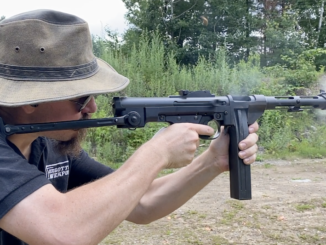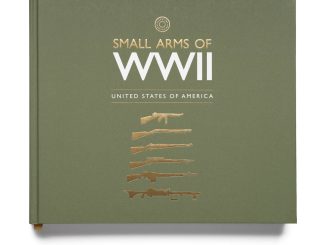RIA’s catalog page for this rifle
The first successful iteration of John Garand’s rifle was developed in 1921 and refined through 1924. A small batch were made for US military testing in 1924, where it was compared to guns like the Bang, Hatcher-Bang, and most significantly the Colt/Thompson Autoloading Rifle. Garand’s rifle was primer-activated, with a downward-tilting locking lug at the rear of the bolt (like an 1886 Mannlicher). It was the clear willer of the trials, but was rendered useless in 1925 when the military adopted a new loading of .03-06 which used IMR powder (with a substantially different pressure curve than wha tGarand had been using for his design) and staked primers – which rendered it thoroughly unusable in the 1924 Garand.
In response, Garand would completely change his design, moving to a rotating bolt with two symmetrical locking lugs and a long stroke gas piston – which would eventually be adopted as the US Rifle M1. However, Garand’s skills as a rifle designer are clear in this 1924 prototype – it handled and balances wonderfully, and has excellent sights and trigger. It disassembles easily, and simply feels robust and svelte in a way that is quite unusual for early semiautomatic rifles.




“in 1925 when the military adopted a new loading of .03-06 which used IMR powder (with a substantially different pressure curve than wha tGarand had been using for his design) and staked primers – which rendered it thoroughly unusable in the 1924 Garand.”
This might need little explanation: in 1920s U.S. Army used Browning 1919 machine gun, which fired from closed-bolt, this mean that there was risk off cook-off (ignition of powder inside chambered cartridge due to heat accumulation), due to design of said machine gun, primer going out its place present real hazard of danger: applying force to firing pin which already was in full rearward position.
Thus it look that Garand after observing that unsupported primer goes out of then used 7,62×63 cartridge though it is not bug, it is feature and crafted rifle using it.
Generally primer-actuated principle looks elegant and might be tempting for someone which want to have fixed (not moving) barrel AND zero holes in barrel, unlike most gas-operated systems. However, it is very dependent on ammunition used, in fact Roth self-loading rifle using such principle and specially made cartridge was tested in Great Britain yet before Great War, see slides 47, 48 and 49 here:
https://www.slideshare.net/tcattermole/early-british-automatic-rifle-trials-a-lecture-to-the-hbsa-of-gb/47
despite using of special cartridge created for that rifle, ammunition failure rate was big. This naturally lead to question what is guilty: rifle or ammunition (flawed manufacturing process?), but even if second such solution might seems to require much tighter tolerances, than typical gas-operated system, to work properly.
Good job! And as always, I find the view into the developmental process fascinating: how things and processes evolve, get changed and refined over time. So we see here, for example, some important ideas such as the handling, the attention to manufacturing, etc. and if we follow the process through to the rifle that was adopted as the M-1 we can see how Garand evolved the design in response to both the internal requirements (reducing part count, etc.) and external requirements such as the different cartridges it was intended for (readers of this web site will, for example, likely know that the M-1 was at one late point designed to hold 10 rounds of .280 Pedersen, and the now-famous 8 rounds is because of the switch to .30-06, etc.) Anyway, the whole development process (which in this case we can trace one designer over almost 15 years on one rifle) is fascinating.
“.280 Pedersen”
Shouldn’t be .276 Pedersen?
Yes that should be the case, the round is about 7 millimeter in diameter… Speaking of that development the toggle delay changed to toggle lock in the ultimate form of the Pedersen rifle, once the developers at Nippon Special Steel opted to use gas operation instead of blowback. And yet another question comes up: why not use a toggle that swings to the side as opposed to straight up? Ultimate answer to lack of mass production toggle locks beyond Maxim and Luger: toggle bolts are freaking expensive!! Did I mess up?
“toggle bolts are freaking expensive!!”
I am not sure about that, taking in account popularity of Maxim (including Vickers) solution in various sizes (cf. 2-pounder Pom-pom used by Royal Navy).
Also, IIRC one comment on forgottenweapons long time ago (by eon if I am not mistaken), Winchester Model 1873 also belong to category “toggle” although it is not self-loading. Considering it was produced until 1920s and in numbers far from small, it must was economically feasible solution.
Okay, let’s get this straight. I haven’t seen mass-issued infantry rifles with toggle-locked actions. The Maxim machine guns are too heavy to act as infantry rifles and the earlier toggle-locked Winchester rifles could NOT handle military grade ammunition like .45-70. It wasn’t until 1895 when a Winchester could handle military grade ammunition and quickly load up with stripper clips. But by that time, the bolt-action rifle was the norm for all “proper” Western armies. I was also referring to actions with EXTERNAL toggles, not INTERNAL toggles.
” I was also referring to actions with EXTERNAL toggles, not INTERNAL toggles.”
Wait, now I confused, never meet such taxonomy earlier. Also, why Maxim machine gun would belong to first?
Anyway, for infantry rifle with side-folding toggle see Heinemann self-loading rifle: http://www.historicalfirearms.info/post/148067062107/heinemann-rifle-designed-by-karl-heinemann-in-the
But the Vickers-Maxim was known to cost 6 times as much as a Lewis Gun. It was worth it for the damage one could do, and its durability.
Wow. This weapon looks like it was fantastically complicated to machine! Even without the primer change that sounded its death knell, I can’t foresee any government adopting it because the expense of mass producing them would be prohibitive.
I am not deep into the history of firearms development… but I am learning! I had never heard of weapons that required LUBRICATION of the cartridge before going into the chamber! Like the moving primer thing, this is something that makes no sense to me today.
J.W.
IIRC one of the Japanese(early 20th cent.)m.g.’s actually had an oil-saturated pad that the cartridges would pass under(over?)to get lubed. I’m guessing they decided to trade excessive bolt/wear for guaranteed extraction on the battlefield….
ras
“never heard of weapons that required LUBRICATION of the cartridge before going into the chamber”
Then see Austria-Hungarian Schwarzlose machine gun.
Another example might be Breda Modello 30:
http://modernfirearms.net/en/machineguns/italy-machineguns/breda-m1930-eng/
with integral oiler
On lubricated cartridges:
Some types of action do need lubricated ammo, notably blowback and delayed blowback in high-pressure calibres where the cartridge case needs to move while pressure is still so high that the brass is expanding hard against the chamber walls.
The CETME/HK family of delayed blowbacks avoid this by having a fluted chamber. FN 5.7 has a low-friction polymer coating on the cartridge brass, the 5.7 pistol and P90 submacinegun would both fail to cycle if you ran dry brass without this coating.
On a more «forgotten weapons» note, I shoot a Winchester 1910 Self Loading rifle which has a slightly rust- pitted chamber. It refuses to cycle at all unless I lubricate the ammo a little bit, but with lune it is very reliable.
Also 20 mm Automatic Gun M1 need special rituals before cartridge loading, according to https://www.ibiblio.org/hyperwar/USA/ref/TM/pdfs/TM9-227.pdf page 120 (PDF):
e.Athough the use of oil or grease on ammunition is generally prohibited, in the case of ammunition for these guns it is necessary to oil the cartridge case in order to prevent jamming. By means of a cloth wrung out of OIL, lubricating, preservative, special, spread a light film of oil evenly over the body of the cartridge case just prior to insertion of the round into the magazine or belt. Extreme care should be taken to prevent oil from getting on the primer or joint at the mouth of the cartridge case. If OIL, lubricating, preservative, special, is not available, use OIL, lubricating, preservative, light. Preferably, only one day’s supply of ammunition should be lubricated at a time. Rounds oiled for firing and not fired at the same day, should be wiped dry to prevent the accumulation of dust and grit, and the seepage of oil around the primer and mouth of the cartridge case. Such rounds will be used first in subsequent firing; they must be oiled again before use.
Wow again! I learn something new every day at Forgotten Weapons.
All these years I’ve been hearing “don’t shoot with an oily chamber… it creates dangerous pressures”. I guess it depends on what you’re shooting, huh?
Any derivate of the Hispano-Suiza HS.404 requires lubed cartridges. That includes the 20 mm Mark 16 naval gun, that’s still in service with the US Coast Guard.
For more data about 20 mm autocannons used by U.S. forces during WWII, see:
http://www.quarryhs.co.uk/US404.htm
It doesn’t affect chamber pressure in any meaningful way, but it certainly does affect bolt thrust by reducing friction between cartridge case and chamber walls. In some cartridge designs, notably straight- walled cartridges with a fairly high pressure, that friction with dry brass may be enough to safely hold pressure even without a breech block. More tapered cartridge designs have comparatively less friction under pressure.
Didn’t mr Ackley put this to the test with his «Ackley improved» version of the .30-30, firing it in a Winchester 94 with the locking lugs removed? If I recall correctly, it worked fine thanks to great friction from the nearly cylindrical case body obturating in the chamber. With oil, that might have been a bad day for mr Ackley.
In the ’20s the US was a fairly rich county with a comparatively small army, so it was possible for them to think to issue any soldier with an high-quality weapon, regardless of the price.
Had this rifle been adopted however, for WWII it would have meant problems, or another design needed for mass production.
Nearly impossible Mr Garand was the inventor of both this and gas operated M1 rifles. A genius coming from that complicated, cumbersome and unpractical thing to the cleverly designed, durable and practical war machine. The development should be overimaginable.
I don’t think the front sight is from a 1903 (5:44). It appears to be a one piece annular mount, no dovetail, no separate blade. The upper and lower barrel bands are certainly straight off a 1903, and the lines of the upper handguard are suggestive of that lineage.
It seems to be a good design for the ’20s, but the quantity of accurate machining required for each of them seems to be at swiss-rifle level.
The British spotter round for the LAW anti-tank weapon is roller locked and primer actuated in a way.The cartridge is a 7.62mmNATO case opened out to 9mm
tracer with a 0.22 Hornet blank as a “primer” that moves back on firing in a
similar manner to a primer actuated system
surrised by the locking lug. I thought that the same kind of the Mannlicher 1886 and 1888 could be used for a stronger ammo